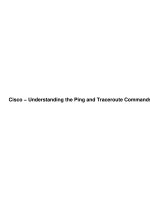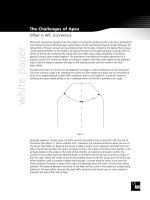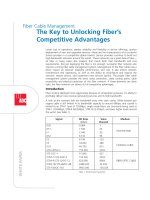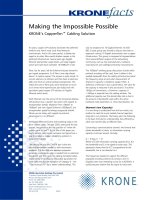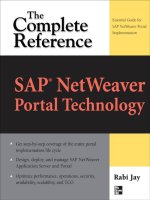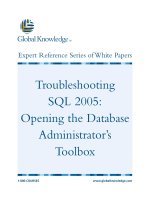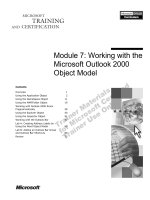Tài liệu CopperTen™ Cabling Solution Making the Impossible Possible ppt
Bạn đang xem bản rút gọn của tài liệu. Xem và tải ngay bản đầy đủ của tài liệu tại đây (180.11 KB, 4 trang )
For years, copper UTP solutions have been the preferred medium over which
most Local Area Networks communicate. And in this same period, a debate
has raged as to when fiber would displace copper as the preferred infrastruc-
ture. Several years ago Gigabit Ethernet seemed like a pipe dream, yet today
Gigabit Switch port sales have overtaken 10/100BaseT of old.
Fiber has for years lead the Ethernet industry forward in port speed progres-
sion. So why, if fiber is one step ahead, doesn’t it replace copper? The answer
is quite simple. To convert Electrons to Photons and then back to Electrons
adds cost (from an active hardware prospective)! This makes the cost of fiber
optic active hardware as much as six times more expensive per port today than
the equivalent speed copper UTP solution on gigabit Ethernet switch ports.
With Ethernet now the winner of the horizontal desktop LAN protocol war, a
pattern has arisen with regards to transportation speed. Migration from
10BaseT to 100BaseT and now Gigabit Ethernet (1000BaseT), the transporta-
tion speed has always progressed tenfold. Where we are today, with regards
to protocol advancement, is no different.
Ten Gigabit Ethernet is alive and breathing today in the form of fiber optics.
The year 2003, particularly the last quarter, was pivotal in the old question of
“when will copper reach its limit”? By the title of this paper you might sur-
mise, yet once again, someone has figured out a way to produce a copper
networking solution to support 10Gig.
The cabling industry (Telecommunication Industry Association (TIA)/Electronic
Industries Alliance (EIA)) doesn’t drive the electrical parameters needed to run
transmission protocols. It is the IEEE who develops proposed protocols, under-
stands what is needed from an electrical standpoint and then gives the TIA
responsibility of developing measurable parameters for cable (with the possible
exception of Category 6 – See “The Evolution of UTP” for a better understand-
ing.). This was no exception for 10Gig Ethernet. An IEEE 802.3 Study Group
was formed to discuss how best to approach running 10Gigabit transmission
over a copper infrastructure. This group is composed of representatives from
several different aspects of the networking community, such as chip manufac-
turers, hardware manufacturers and cabling/connectivity manufacturers.
The 10GBaseT working group discussions include which protocol encoding will
be used, how it relates to the needed bandwidth from the cabling infrastruc-
ture (what the frequency range is) and what Shannon’s Capacity is needed to
support them. A definition of Shannon's law is given below. The value for the
capacity is measured in bits per second. To achieve 10Gbps of transmission, a
Shannon’s capacity of >18Gbps is required from the cabling solution. The
additional capacity over the desired data rate is due to the amount of band-
width used within the active hardware noise parameters i.e. Jitter,
Quantization, etc.
CopperTen
™
Cabling Solution
Making the Impossible Possible
CopperTen
™
Cabling Solution: Making the Impossible Possible
Page 2
Shannon's law (Capacity)
It is one thing to understand how this law works, but
another to meet the much needed channel capacities
required to run protocols. That being said, the following
is the basic formula for understanding how efficiently a
cable can transmit data at different rates.
Concerning a communications channel: the formula
that relates bandwidth in Hertz, to information carrying
capacity in bits per second. Formally:
Q = B log2 (1 + S)
Where Q is the information carrying capacity (ICC), B is
the bandwidth and S is the signal-to-noise ratio. This
expression shows that the ICC is proportional to the
bandwidth, but is not identical to it.
The frequencies needed to support the different pro-
posed encoding schemes, to achieve a full 10Gig were
now extending out as far as 625MHz. It quickly became
evident that the signal to noise ratio within a cabling
solution could be predicted, and therefore, cancelled
out within the active electronics. A random noise
source, Alien Crosstalk, now existed from outside the
cable. This noise source would need to be measured
and reduced to achieve the Shannon’s Capacity require-
ments of the cabling solution.
You may be aware of how the industry currently pre-
vents the effects of crosstalk within cables. The pairs
within a single cable are twisted at different rates (as
the different colors in the cable would indicate). These
different rates are used in an effort to minimize the
crosstalk between pairs along parallel runs. While this
works well within the cable, it doesn’t do much for
cable-to-cable crosstalk (Alien Crosstalk).
Alien Crosstalk is quite simply the amount of noise
measured on a pair within a cable induced from an adja-
cent cable. This isn’t a concern for different twist lay
pairs between cables. Where this has the highest impact
is between same twist lay pairs between adjacent cables.
Initial testing on existing Cat 6 UTP cable designs quickly
showed that the rationale behind reducing the impact of
crosstalk between pairs, within a cable, could not sup-
port Alien Crosstalk requirements. Twist lay variation and
controlled distance between the pairs have been stan-
dard design practice for achieving Category 6 compli-
ance. While the distance between pairs can be con-
trolled within a cable jacket, it could not be controlled
between same lay length pairs on adjacent cables.
Testing to Shannon’s Capacity on existing Category 6
UTP solutions only yielded results in the 9Gbps range.
The results achieved previously did not provide the
needed additional throughput to allow for active elec-
tronic anomalies. This was a far cry from the desired
19Gbps. Therefore the question to be asked: Is there a
UTP solution capable of achieving the needed Alien
Crosstalk requirements or would fiber finally rule the
day? The August 2003 meeting of the working group
would yield three main proposals as a result.
1. Lower the data rates to 2.5Gbps for Cat 6 UTP. This
would be the first time fiber would not be matched
in speed and that a tenfold increase in speed would
not be achieved.
2. Reduce the length of the supported channel to 55m
from the industry standard 100m for Cat 6 UTP. This
would greatly impact the flexibility of the cabling
plant, considering most facilities are designed with
the 100m distance incorporated into the floor plans.
Figure 1. Example of a
center cable being
impacted by the adjacent
6 cables in the bundle.
Figure 3. The star filler used
within several Cat 6 cable
designs increases and controls
the distance between pairs.
Figure 2. Example of
how cables with
same twist lays
impact one another.
Figure 4. While the
distance between
pairs within the same
cable is maintained,
the distance between
same lay lengths on
adjacent cables is still
compromised.
CopperTen
™
Cabling Solution: Making the Impossible Possible
Page 3
3. Use shielded solutions and abandon UTP as a trans-
port medium for 10Gig. This would mean returning
to ScTP/FTP type solutions, requiring additional labor,
product cost and grounding, as well as space.
Category 5e would also be dropped as a proposed
transport medium entirely. The active hardware and chip
manufacturers would now be faced with a lesser solu-
tion than the already available Fiber Optic solution. And,
questions would now be raised concerning the value of
producing such active hardware to support transmission
rates that only increased by 2.5 times, or if distance limi-
tations of 55m were really worthwhile? Would the addi-
tional cost of installing a shielded solution outweigh the
benefits in cost for the active components?
The next meeting of the working group would be piv-
otal in addressing the above questions. UTP could very
well have reached its limit.
KRONE INNOVATION CopperTen
™
A momentous challenge was now presented. How
could a UTP cable achieve the desired capacity of
>18Gbps, maintain the 100m distances to which the
industry has become accustomed while remaining with-
in normal size constraints?
In response to the challenge, KRONE’s research and
development team quickly went to work. Working with-
in a very short developmental timeframe several innova-
tive ideas were presented, tested and then put into pro-
duction. Almost overnight, the KRONE R&D team pre-
sented a solution to the 10Gig, 100m UTP problem.
Addressing Pair Separation
With standard Cat 6 cable construction the pair separa-
tion within the cable is counter productive for pair sep-
aration between cables. The often-used star filler
pushed the pairs within the cable as close to the jacket
as possible leaving same pair combinations between
cables susceptible to high levels of crosstalk.
With KRONE’s new design of CopperTentm Cat 6 cable
the pairs are now kept apart by creating a higher
degree of separation through a unique oblique star filler
design. Crowned high points are designed into the filler
push the cables away from one another within the bun-
dle. This is very similar to a rotating cam lobe.
Due to the oblique shape of the star, the pairs remain
close to the center, while remaining off-center as the cable
rotates, creating a random oscillating separation effect.
The bundled cables now have sufficient separation
between same lay length (same color) pairs to prevent
Alien Crosstalk.
This separation can be better understood through the
actual cross section below. KRONE’s unique design keeps
cable pairs of the same twist rate within different cables
at a greater distance from one another than in the past.
Similar to KRONE’s patented AirES
®
technology cable
design, air is used between these pairs.
Oblique, elliptical, offset
filler, which rotates along
its length to create an air
gap between the cables
within a bundle.
Web Site: www.adc.com
From North America, Call Toll Free: 1-800-366-3891 • Outside of North America: +1-952-938-8080
Fax: +1-952-917-3237 • For a listing of ADC’s global sales office locations, please refer to our web site.
WHITE PAPER
ADC Telecommunications, Inc., P.O. Box 1101, Minneapolis, Minnesota USA 55440-1101
Specifications published here are current as of the date of publication of this document. Because we are continuous-
ly improving our products, ADC reserves the right to change specifications without prior notice. At any time, you
may verify product specifications by contacting our headquarters office in Minneapolis. ADC Telecommunications,
Inc. views its patent portfolio as an important corporate asset and vigorously enforces its patents. Products or
features contained herein may be covered by one or more U.S. or foreign patents. An Equal Opportunity Employer
1326518 5/05 Original © 2005 ADC Telecommunications, Inc. All Rights Reserved
KRONE
®
is a registered trademark of ADC Telecommunications, Inc.
This effect is even more dramatic when viewed
from the side of a cable bundle. The peaks of the
oblique, elliptical filler (red arrows) are used as
the contact points along the length of the run.
These provide the greatest distance between the
actual pairs by vaulting the sides of the ellipse
(yellow arrows) where the pairs are housed.
The reduction of Alien Crosstalk is now greatly
improved over the standard design Cat 6 cables
we use today. The chart below compares meas-
urements made on standard Cat 6 cable and
the new CopperTentm Cat 6. The improve-
ments are approximately 23dB better on
CopperTentm than the standard Cat 6. To put
this in prospective: for every 3dB of extra noise
there’s a doubling effect resulting in standard
Cat 6 cable being more than six times noisier
than KRONE CopperTentm Cat 6.
For the purpose of comparison, the Cat 7 limit
line was used to show the dramatic improve-
ment in preventing Alien Crosstalk.
This ability to create a future-proofing cable in
CopperTentm Cat 6 brings up a question as to
the need for Standard Cat 6 cable, a cable sold
and purchased (for the most part) in an effort
to support the next technology leap.
The industry now has taken that next leap.
Copper UTP has been given another lease on
life to support the next future proofing step in
a 10Gig transport protocol. The cost of active
hardware will remain in check and be cost
effective for future advancements in data trans-
fer rate speeds.
Could this mean Standard Cat 6 is now in the
same category as its Cat 2 and Cat 4 predecessors?
